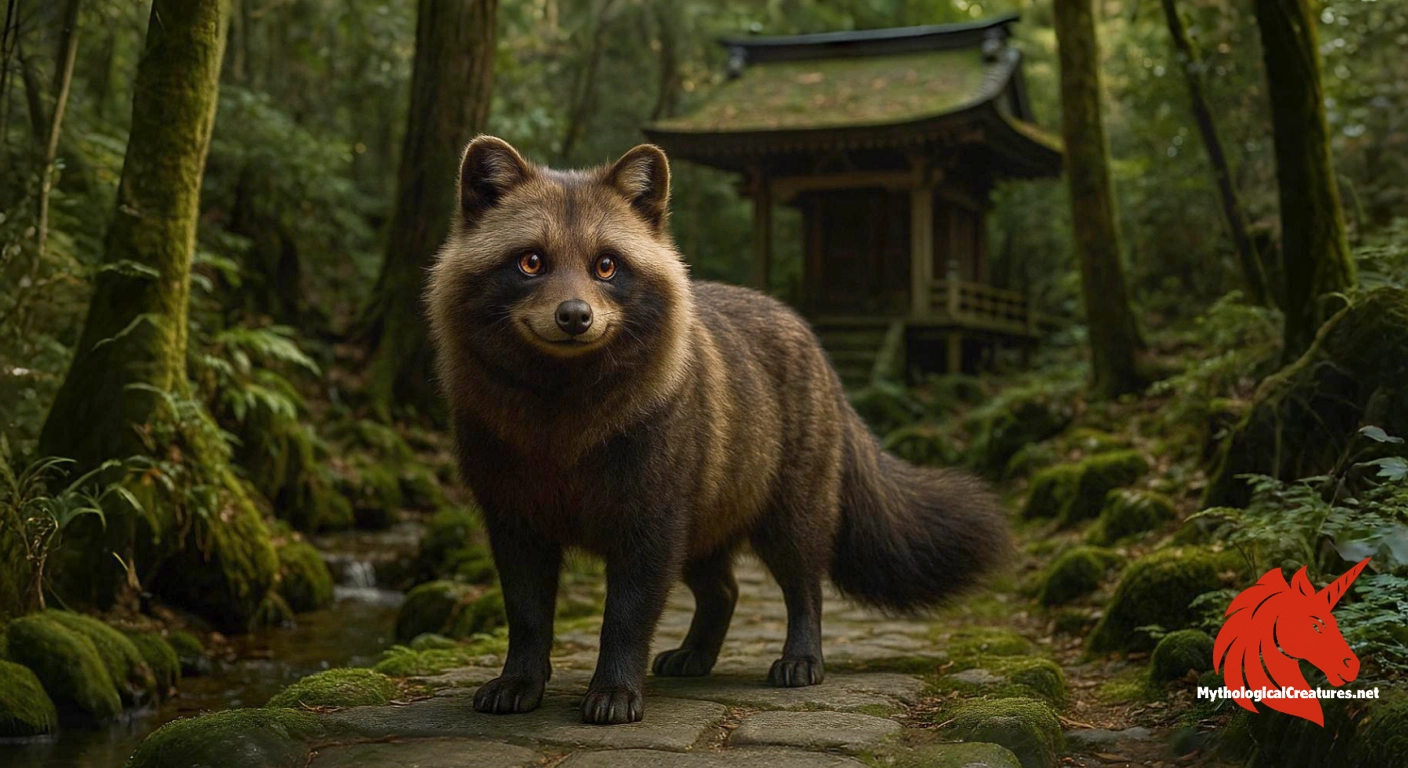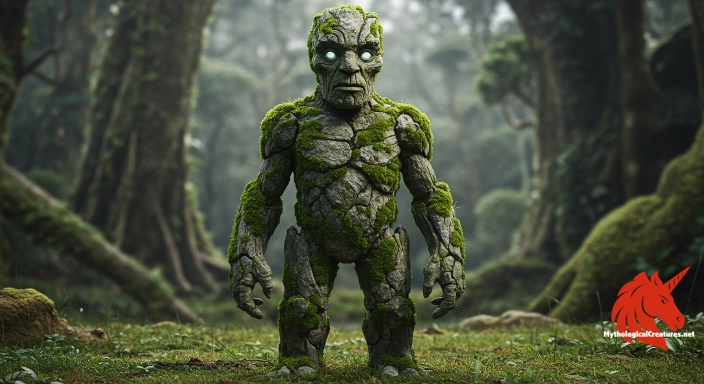Bake-danuki: Bake-danuki are supernatural raccoon dogs from Japanese folklore known for their remarkable shapeshifting abilities and playful trickery.

Bake-danuki
Bake-danuki - Represents the mystical and unpredictable nature of the supernatural in Japan, often serving as a cautionary and humorous figure in local legends
Origins & First Encounters
The Bake-danuki is a captivating figure within Japanese folklore, blending the tangible essence of a real animal with the ethereal qualities of a supernatural being. Its origins are interwoven with the rich strands of classical literature and local legend, creating a character that has evolved over centuries. Early accounts thread together natural observations of the tanuki with imaginative embellishments that highlight its magical abilities. This creature emerges at the nexus of myth and everyday life, embodying both mischief and an unpredictable charm. The cultural context of Japan, where nature and the supernatural are often seen as intimately connected, provides fertile ground for its enduring stories. Over time, the Bake-danuki has been portrayed as a shape-shifter capable of assuming human forms and other curious disguises. Its narrative is steeped in both humorous anecdotes and moral reflections that mirror the complexities of life. The multifaceted depictions honour the balance between reverence and lighthearted caution that informs many traditional Japanese tales. Ultimately, the Bake-danuki continues to enchant audiences, serving as a timeless reminder of the magic that thrives at the edge of the known world.
Source Texts & Tale Variants
The narratives of the Bake-danuki are preserved in a diverse array of sources, ranging from ancient manuscripts to vibrant local oral traditions. Early texts and folklore collections reveal a creature celebrated for its mysterious shapeshifting and playful mischief. Literary records capture a series of adventures that often cast the Bake-danuki in roles both enigmatic and delightfully unpredictable. Multiple story variants have emerged, each offering unique details such as the celebrated exploits of figures like Danzaburou-danuki, Kinchō-tanuki, and Rokuemon-tanuki. Community rituals and regional recountings further embellish these narratives, granting the creature a living presence in local customs. The stories often emphasise its ability to mirror human behaviour and manipulate appearances, weaving together elements of both wonder and caution. Diverse literary and folklore traditions have not only immortalised its escapades but also allowed the myth to morph over time. As tales migrated from one region to the next, subtle differences enriched the overall tapestry of its legend. The enduring resonance of these sources underlines the Bake-danuki’s pivotal role as a bearer of cultural imagination and moral nuance.
Form & Powers
Visual depictions of the Bake-danuki are infused with both naturalistic detail and imaginative exaggeration. Artists often base its form on the real Japanese raccoon dog, yet infuse the creature with an otherworldly quality that sets it apart from its mundane counterpart. Rich, earthy fur tones—from deep russet to soft grey—are frequently highlighted to evoke a sense of ancient mystery and magic. The creature is typically portrayed with lively, twinkling eyes that seem to harbour secret mischief, complimented by ears and a tail that suggest both agility and charm. In many representations, its round, plump form is balanced by an expressive face that communicates cunning intelligence. Some portrayals even lend the Bake-danuki subtle anthropomorphic features, with an almost knowing smile and a posture that hints at a readiness to transform. Every detail, from a slightly elongated snout to a robust physique, symbolises the fusion of the tangible and the enchanted. The interplay of shadow and light in these images accentuates its magical aura, inviting viewers to peer into its enigmatic world. Over time, these physical characteristics have become emblematic of a creature that exists both on the periphery of reality and in the realm of the fantastical.
Regional Faces
The character of the Bake-danuki varies widely across different regions of Japan, reflecting unique local cultural influences and historical experiences. In the Sado Islands of Niigata Prefecture, for instance, the creature is interwoven with community rituals that celebrate its magical influence and mysterious charm. Shikoku’s local legends place an even greater emphasis on its shapeshifting prowess, portraying it as a master of disguise able to move effortlessly between the natural and human realms. In Awa Province, now known as Tokushima Prefecture, distinct variants of the myth emerge where individual tanuki bear unique names and personalities. Regions such as Kagawa Prefecture introduce the narrative of the Yashima no Hage-tanuki, adding complexity by interlacing moral lessons with its trickster image. The regional portrayals often adjust the balance between mischief and benevolence to suit local tastes, resulting in a colourful spectrum of characteristics. In some areas, the Bake-danuki is revered almost like a guardian spirit, while in others it is celebrated primarily for its humour and unpredictable nature. Local art forms—from sculpture to painting—capture these regional nuances with an artistry that both preserves and reinvents the myth. Such variations underscore how local community values and traditions continue to shape the legendary identity of the Bake-danuki.
Cultural Parallels
Exploring the Bake-danuki in relation to other mythical entities reveals a compelling web of similarities and contrasts across global folklore. Its celebrated ability to shift forms invites natural comparisons with Japan’s own kitsune, another shapeshifting trickster enshrouded in mystery and charm. Beyond the Japanese context, similar figures can be found in various cultures, echoing themes of transformation and cunning found in other trickster archetypes. The creature shares a kinship with the ever-adaptable spirit of folklore found in Eastern mythologies, where the boundaries between human and animal blur with enchanting fluidity. In many respects, the Bake-danuki embodies the universal motif of nature’s playful unpredictability, a trait also attributed to figures like the coyote in Native American traditions. The interplay between its real-world animal form and supernatural traits creates a rich tapestry reminiscent of other cross-cultural myths that celebrate the magic of the natural world. Such comparative insights highlight the Bake-danuki’s unique role as both a tangible animal and an ethereal trickster. The blend of earthy reality with mystical embellishment places it at a fascinating crossroads of cultural storytelling. This synthesis encourages a broader appreciation of how various cultures utilise animal symbolism to articulate ideas of change, ingenuity, and the enigmatic forces of nature.
Legacy & Modern Evolution
The historical evolution of the Bake-danuki illuminates a fascinating journey from early literary sketches to a modern icon in Japanese popular culture. Early depictions in classical narratives have gradually converged with vibrant local traditions, forging a figure that is as mutable as it is memorable. With every retelling, the myth has welcomed new layers of meaning and nuance, reflecting shifts in societal attitudes toward nature and the supernatural. In contemporary times, the Bake-danuki has found fresh expression in anime, cinema, and even themed attractions, blending tradition with modern pop aesthetics. Its representation now frequently merges humour, nostalgia, and a subtle critique of modernity, bridging centuries of cultural evolution. Periodic festivals and locally revered sculptures continue to honour its legacy, ensuring that the spirit of the myth remains alive in public imagination. The modern reinterpretation of the Bake-danuki invokes both a sense of playful mischief and a respectful nod to its storied past. Its enduring charm encapsulates the power of myth to adapt and endure amid rapidly changing cultural landscapes. The ongoing fascination with this enigmatic creature serves as a reminder of how traditional folklore can evolve to inspire new generations while retaining its timeless appeal.
Interesting Fact
In traditional Japanese art, bake-danuki are often portrayed with an exaggerated, playful grin and curiously rounded features, reflecting their role as both tricksters and cultural icons.
Quick Creature Info
Features:
Associations:
Our Mythic Legendary Rating:

Also Sometimes Known As:
Habitat:
Supernatural Powers:
Physical Attributes:
Abilities:
Behavior:
Lore:
References
Discover Another Mythical Legend You May Not Have Heard Of?
Uncover the mysteries of ancient folklore and expand your knowledge of legendary beings from cultures around the world.
Dare to Meet the Tipua....
Mythical Disclaimer: The images and data on this site are derived from various historical and literary sources, but we have found that many myths often have multiple versions and interpretations across references, sometimes contradictory. As a result, these creature depictions are artistic interpretations—imaginative blends of folklore, legend, and a dash of AI guesswork. Because creature descriptions vary widely, our illustrations and accompanying information represent our best effort to honor mythology while bridging creative gaps. Enjoy these interpretations—just remember, we've done our best to respect the stories and validate available data, but in the realm of mythology, details often shift, imagination leads the way, and nothing is ever set in stone!
Curated by the Mythological Creatures Team (rev. May 2025)
